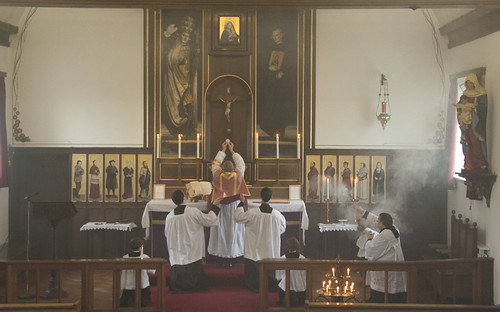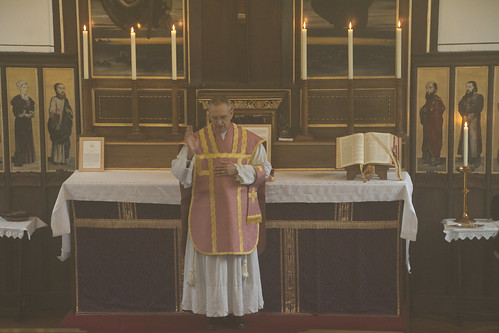
Yesterday was Mothering Sunday; it was also the 3rd Sunday of the month, and so there was a Sung Mass at SS Gregory and Augustine's, where Fr John Saward wore his Rose vestments.
The connection between Laerare Sunday, Rose Vestments, and mothers, is somewhat obscure. Fr John explained in his sermon that the Station Church for the day is Sta Croce in Jerusalem, a church which originated as the palace chapel of the palace belonging to St Helen, mother of the Emperor Constantine and finder of the True Cross. She wished to make this chapel a little piece of Jerusalem in Rome, even digging soil from Mount Calvary into the foundations. When the Pope and people of Rome go to Sta Croce they are, therefore, visiting Jerusalem, symbolically, the original fountain-head of the Church. There are many references to Jerusalem in the propers of the Mass.

According to Fr Mark Elvins, in his book 'Catholic Trivia', the connection with mothers is suggested by one of these references, in which St Paul (Galatians) is giving an allegorical interpretation (Biblical critics of a sensitive disposition, look away now) of the story of Isaac and Ishmail, the two sons of Abraham, one by the free wife Sarah, according to God's promise, and one by the slave Hagar. The Christians are the children of the promise, and of the heavenly Jerusalem represented by Sarah.
 4:26f But that Jerusalem which is above is free: which is our mother. For it is written: Rejoice, thou barren, that bearest not: break forth and cry thou that travailest not: for many are the children of the desolate, more than of her that hath a husband.
4:26f But that Jerusalem which is above is free: which is our mother. For it is written: Rejoice, thou barren, that bearest not: break forth and cry thou that travailest not: for many are the children of the desolate, more than of her that hath a husband.Ille autem, quæ sursum est Jerusalem, libera est, quæ est mater nostra. Scriptum est enim: Lætare, sterilis, quæ non paris; erumpe et clama, quæ non parturis: quia multi filii desertæ, magis quam ejus quæ habet virum.
Today the Pope can bless a golden rose, and present it to a Catholic monarch, church or shrine; this apparently suggested Rose coloured vestments. It is interesting that this charming custom is carried out in this joyful interlude of Lent, rather than on a more obviously festive occasion.
A 14th Century golden rose, right, from the Wikipedia article.
More photos of Mass.
No comments:
Post a Comment